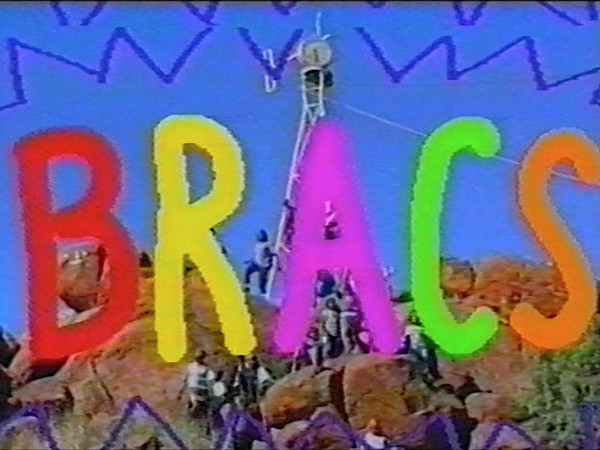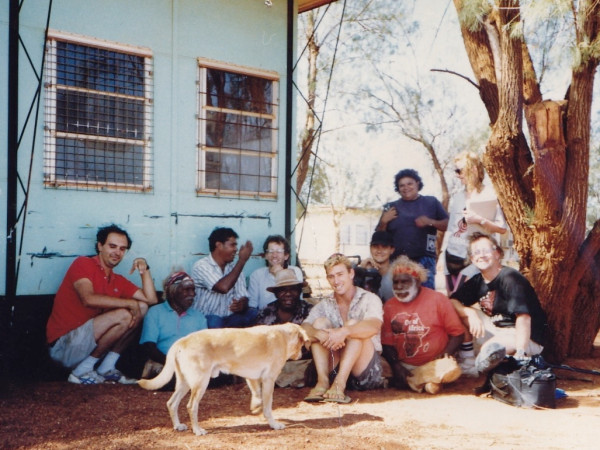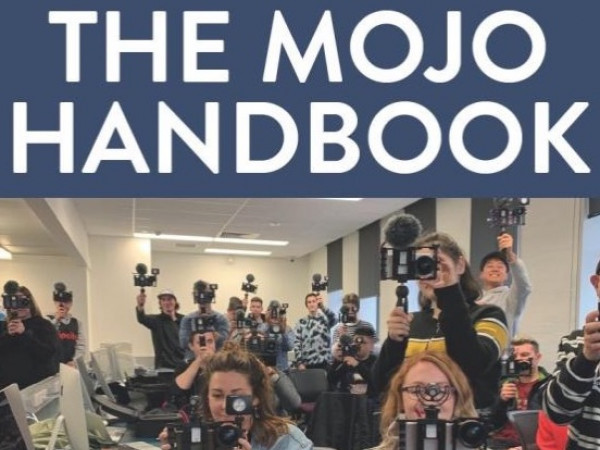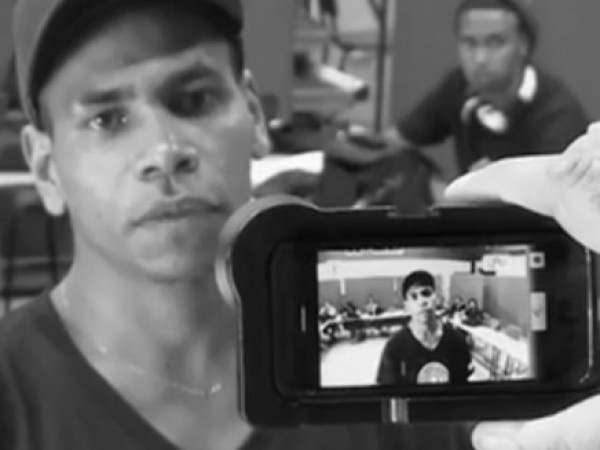Ivo Burum
“It’s all about self-determination”
I was hired at CAAMA to be the executive producer of CAAMA Productions, which had just kind of started in name really, and CAAMA Productions was the corporate production house, the ‘corporate’ production house of CAAMA. It was meant to be self, self-funding, which was different to much of CAAMA.
I came out of commercial TV, and came there, that was my imperative. That was my instructions from Phillip [Batty] and Freda [Glynn] - to get this thing - and the accountant Peter Hughes - get this thing going, get it looking after itself and then we'll be happy. Well, we tried to do that but it wasn't all that easy because in that you still have a whole lot of cultural imperatives that need to be addressed and adhered to.
And one of my roles apart from generating commercial product, was training, and we ran a training program there, where we had you know two amazing filmmakers today, Warwick Thornton and Rachel Perkins, and a great cinematographer Alan Collins.Satellite Dreaming … was a project that we worked up with Tony Dowmunt … with you, from England and it was a Channel 4 project? [Tony: It was…] And it was a really interesting project in that it was it was a project that explored the indigenous use of television really, or in media really, because we looked at radio as well. But …and we looked at what we were doing at CAAMA, we looked at what the ABC was doing, we looked at what SBS was doing, and we looked at what indigenous people were doing in those three environments involved in the media.It was the first real documentation of how indigenous people were using the media and in the project we spoke to a couple of Indigenous filmmakers who had been making stuff for a long time and of course we spoke to the three networks that I talked about: CAAMA, the ABC and SBS.
And I remember the most outstanding moment for me was the, the women, all the women … there were two moments: one was the amount of sugar that they drank in their coffee - that we had to go and buy - we had to travel 200 kilometres return trip to go and buy more sugar. And we couldn't talk them out of… talk the indigenous people out of drinking sugar, that much sugar on their coffee. The other thing, the other event was a cultural event which was really, which is really amazing. It was that the indigenous women took … the women on our team away and painted them up, and then did this ceremony and this dance, and then the men did this dance and the ground shook. It was a dance I hadn't been done for 30 years and we could feel the ground shaking. And in an instant, really, in an instant this whole Indigenous connection to this world, to this ground became apparent. It’s stuff that we can't really even rationalize
You asked me about how, the importance of Satellite Dreaming really, and the relevance of …it as a document really - a cultural document more than anything I think. And it was relevant in that it was made at a point in time where, where CAAMA was changing. There was a point in time where Philip and Freda were leaving CAAMA in the most unusual circumstances and the time - and I of course came to CAAMA because of Philip and Freda, because of their dream and their inspiration. That's why I was there. And er… but … we made Satellite Dreaming because it was indicative of what was going on there. But as it happened, it was the time just as Philip and Freda were leaving. And it was really interesting and I kind of thought about this a lot and about whether they should be there or why they'd gone and all the circumstances surrounding that. And I was particularly thinking about these circumstances when I offered the film to Imparja because as you probably realize that CAAMA owned 51 percent of Imparja -in fact Philip and Freda won the licence of Imparja. And erm …so I offered it to Imparja as a film for a thousand dollars because we were….a one hour documentary for a thousand dollars. That's pretty cheap. Even back then. Right. And they said no - basically because they had nowhere to program it. And I said, ‘but you're an Indigenous Network, you've got to have somewhere to program it’. Anyway, I offered it for zero as well. And they still said no, so they didn't take it, yet it was sold to the Channel 4 hadit, … the ABC had it and it was sold really everywhere. So, this was really …disconcerting. It was an Indigenous Network not wanting to take their own product, which was indigenous and high quality product.
It's all about self-determination. The real question is how much was Imparja about self-helping…helping people become self-determinant.
In a couple of years before I got there the government had rolled out what was called a Broadcast for Remote Aboriginal Communities scheme, the BRACS scheme. Ostensibly what that was, was a satellite receiver in a community and they were able to receive a television for the first time, and they were able to broadcast that television to their community, and radio to their community, and then they were able to switch that off, make their own programmes and broadcast those programmes to the community. Well that was a theory and in some communities like Ernabella where the amazing Neil Turner was working helping people, that was a reality and that happened and the programming was terrific. But in many other communities the BRACS system, to a point failed - it was still great that the indigenous people receive this, this content and they were able to choose the content from the outside world… but they weren't making their own content and, you know on a Friday and Saturday night when they could have been screening their own films, they were watching reruns of Dirty Harry and Magnum Force and that wasn't what was intended - and so training let that whole program down I believe.
And when I went back to mainstream television I went back to the ABC, and after a couple of years at the ABC of doing traditional programming I developed a series called Home Truths. Home Truths was a series that, where 20 Australian families, observational series, filmed their own lives. And we then edited that into programmes, into ten half hour programmes. That was directly a result of the work at the BRACS units - or the lack of work at the BRACS units. What I thought when I got out of Central Australia was how can I do this. How can I expose ordinary people to this medium of ours, the medium I was working in - television. And so that's a direct that's a direct pinch from the BRACS that's what BRACS was trying to do. So we taught people to make programmes, and subsequently I did another … Mostly I did mainstream television, prime time TV, but every so often they'd let me play in Field of Dreams and I did a series called Nurses where my brother passed away at the Alfred Hospital, and I thought the nurses were really amazing so I went in there. It took me a couple of years to raise the money but we made a series where the nurses filmed their own lives, telling their own stories from their own perspective. And then … we had the terrible bushfires in Canberra. I did the series documentary that the people themselves filmed, rebuilding their lives after the bushfires. So all that's directly related to my experience in, at CAAMA and in particular BRACS. So that's informed a lot of my work, of my factual work.
For the last little while I've been involved in Mojo - what I call Mojo - which is mobile journalism. And it's using small mobile devices like, small cameras like the iPhone, with onboard edit facilities to create stories. So it involves teaching people to use the technology and involves teaching them storytelling. Okay?
As much as we did in those series at the ABC where all these mojo skills came from - as much as we did there, we were still making the product, we were still finishing the product. People like you, people were shooting it but we were editing it. With Mojo the actual journalists, the mobile journalist actually gets a chance to edit it there on their little device and then upload it to a website.The first of the Mojo projects…so it's like a 20 year cycle, the first of the major projects went back into the NT where we found…It's called NT Mojo …and the works…you can see the work on a website called NT Mojo . And what it is - we got nine mojos from six different, from five different communities and we taught them how to use this equipment over a period of week. We had an intensive week of training and then I travelled with another trainer, travelled through communities helping them make the stories, and continuing the training for another four or five weeks. And as I said the result is on, is on a website and it's a really empowering, empowering format for enabling people to have their own voice in the media - because one thing they're doing is that they're actually telling their own stories, completely finishing them from their own perspective, which is really amazing in itself. Two is, they're doing it from their own community so that informs the story, yeah? And three is that they are actually able to upload this stuff because of the wonderful communication that exists out there in communities now - much quicker than from here even - they're able to upload it via 3G or Wi-Fi for the world to see. So, they were able to have their own voice, they were able to create their own voice. And where the Mojo project is going no, it's since, since the NT Mojo, it's been rolled out in schools in Victoria, in China - we taught the first ten mojos in China - and at Deakin University where we're rolling it into their journalism course. But going back to the Northern Territory now because, you and I both know that doing this once as a once off is not really … it's good and it's great but what you need is sustainability. And so what we're looking for is sustainability for Mojo, and we're now going to roll it out in a secondary school in the Northern Territory and in the hope that teaching some of the teachers to be able to do it and then having the teachers there to teach the students will form…will give it sustainability and longevity
So Mojo is mobile journalism and it's mobile journalism so it's hand-held. It's part of the new revolution because we've moved from personal computing to intimate computing which this is. So there's the iPhone, we're using the iPhone at the moment and the iPhone fits into a little device here called an OWLI which gives it you know you can go I… can do some stuff of I can shoot you or just get a thing happening here and. And…. There we go. You are still backlit of course but …we’ll have to wait to see who’s …wait to see who's who's steadier. You know because there you go. So that's mojo. And what we do, we can put a mic on the top of that. Or we can put a lot of light on the top of that…so you know, which is quite a quite a powerful rechargeable light. And there's a very there's a various permutations of this kit. There's a little mic that can go in the side as well you know. And you can you can put you can put other lenses on the front if you want to have the big lenses. Right. Which kind of defeats the purpose of… having mojo really because mojo’s meant to be intimate …. So there's a little magic kit and this is what the NT Mojos use. They used kit like this. That's how they made these stories…
There's an edit package where you can edit stories - it's a timeline - you can you can move around stuff around around the timeline - you know, there it is there.
So it has four tracks of audio, so it's quite professional in that sense, and it's you know the high quality you know the new the new iPhone is 1920 by 1080. So it's high quality. I mean it’s broadcast HD quality so. So it's a nice little package that that's …you know in the old days we used to buy Betacams and stuff in communities or whatever - even those cameras. If here, for you know under a thousand dollars you can have a broadcast quality production kit, so you can have a number of them in the communities -all that's left to do is to teach people how to use it. Because it's about the training, it's not about the technology …you know …and the technology is not going to not going to cure the woes of the world - it's how we use a technology that will change the world and create a better place for all of us to live.




